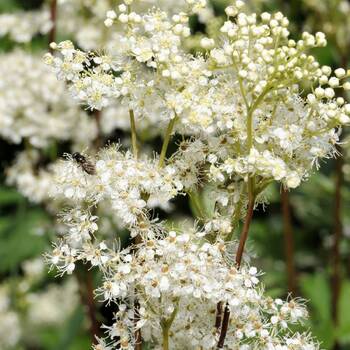
How to Grow Meadowsweet Seeds
Grow Guide #3058
Family: Rosaceae
Binomial name: Filipendula ulmaria
Life Cycle: Perennial
This 'How to Grow' guide details everything a home gardener needs to know to plant, grow and care for Meadowsweet (Filipendula ulmaria).
Meadowsweet (Filipendula ulmaria) is a clump-forming perennial herb with serrated, lance-shaped leaves and dense clusters of creamy-white flowers. It is commonly found in moist habitats, such as meadows, riverbanks, and woodlands. Attractive to pollinators, meadowsweet grows well as part of wildflower plantings, flower borders, and cottage gardens.
Meadowsweet Growing Conditions
● Climate: Grows best in temperate climates and is adaptable to cooler conditions. In subtropical, tropical, and arid climates, meadowsweet may need protection from extreme heat. Consider that the seeds may struggle to germinate in hotter temperatures.
● Soil: Grows well in consistently moist, fertile soil that is well-draining, but can tolerate poorly-draining soil. Avoid particularly dry or sandy soils.
● Sun exposure: Prefers full sun but tolerates partial shade.
When to Sow Meadowsweet Seeds
In cool and temperate climates, sow seeds in late autumn or early spring. In subtropical climates, sow in early autumn or late winter.
| JAN | FEB | MAR | APR | MAY | JUN | JUL | AUG | SEP | OCT | NOV | DEC | |
|---|---|---|---|---|---|---|---|---|---|---|---|---|
| Cool | ||||||||||||
| Temperate | ||||||||||||
| Sub-Tropical | ||||||||||||
| Tropical | ||||||||||||
| Arid |
Meadowsweet Seed Preparation
Meadowsweet seeds require a period of cold (stratification) to break dormancy. In climates with cool winters, sowing seeds in the late autumn will provide natural stratification. If sowing in the spring, simulate winter conditions by refrigerating for 4 to 6 weeks before sowing.
Tip: When refrigerating meadowsweet seeds, place in a plastic bag with moist paper towel to prevent drying. Check on the seeds every week to provide ventilation and remoisten if necessary.
How to Grow Meadowsweet from Seed
Meadowsweet seeds can be sown directly in the garden or started in seed trays. Consider that the seeds can take 21 days or more to germinate and do best in temperatures between 15-21°C. Meadowsweet seeds require sufficient moisture and light to germinate. Note that germination of this species can be slow and inconsistent.
Sowing In-situ
- Choose a location that receives full to partial sun.
- Prepare the soil for planting by removing weeds, incorporating organic matter, and finely raking the surface.
- Water the soil well.
- Sow seeds around 3cm apart and lightly press into the soil.
- Water again with a fine rose or mist, taking care to water the seeds safely to stop them washing away.
- Keep the area free of weeds and water regularly.
- Once the seedlings are large enough to handle, thin them out, leaving the strongest plants around 30 cm apart.
Sowing in Seed Trays
- Fill a seed tray with a mix of compost and vermiculite or a seed-starting potting mix.
- Water the soil well.
- Sow seeds 3cm apart on the soil’s surface and press lightly into the soil.
- Carefully mist with water.
- For seeds sown in autumn, leave the seed tray outside or in a cold frame to overwinter.
- Maintain consistent moisture.
- Once the seedlings are large enough to handle, transplant into individual pots to grow on.
- Plant out well-established plants later in the year.
Note: Meadowsweet seedlings tend to be slow-growing and may not display significant growth until the second growing season. If necessary, plantlets can be grown in pots for the first year and planted out the following spring or summer.
Meadowsweet Ongoing Care
Watering
Meadowsweet thrives in moist conditions, so avoid letting the soil dry completely. When watering your garden, do so in the early morning or late afternoon to prevent sun scorch or water loss through evaporation.
Mulching
Add a layer of mulch 5 to 7 cm thick around the base of the plants to retain moisture and suppress weeds. Keep the mulch a few centimetres away from the base of the plant to prevent moisture buildup that can cause rot around the stems. Good mulch options include compost, straw, or leaf mould.
Fertilising
Incorporating organic matter, such as compost, into the soil before planting will supply meadowsweet with sufficient nutrients for the first growing year. In its second year, apply a balanced, organic fertiliser in the spring to support healthy growth and flowering.
Tip: Composting at home is a great way to transform garden and household waste into a valuable, nutrient-rich product for your plants. Take a look at our composting for beginners guide to get started with your own composting system.
Pruning
Cut back spent flower stalks after flowering to maintain a neater appearance. Note that pruning the flowers of this species will not encourage a second bloom—meadowsweet flowers just once in the season. In late autumn or early spring, trim back any dead or damaged stems to prepare the plant for new growth. Make sure to use sharp, sterilised scissors or shears when pruning your plants.
Flowering
In their second growing season, meadowsweet produces a single flush of flowers in mid-late summer, with blooms lasting up to 4 to 6 weeks. Avoid nitrogen-rich fertilisers that can encourage foliage growth over flowers.
Tip: Meadowsweet flowers are edible and are commonly grown as part of herb gardens. The sweet, fragrant flowers can be used in teas and tinctures or in natural perfumes.
Propagating Meadowsweet by Division
Well-established meadowsweet plants can be propagated by division. Divide in the early spring before the plant resumes active growth.
- Carefully dig around the base of the plant, lifting it out of the ground with a spade or fork.
- Gently pull apart the root ball or use a clean, sterilised knife to separate into two parts, ensuring each division has healthy stems and roots.
- Plant each division in moist, well-draining soil at the same depth as the original plant. Divided plants can also be grown on in containers.
- Water well to help establish and provide the same care as with the parent plants.
Meadowsweet Common Problems
While meadowsweet is generally low-maintenance, it may experience some fungal diseases. Regular monitoring and sound gardening practices will help to prevent significant infestations. Fungi tend to thrive in warm, humid conditions, so ensure good air circulation, thin out plants to prevent overcrowding, and avoid overhead watering. As with any infected plants, remove and destroy affected plant material.
- Powdery Mildew: This fungal disease is characterised by a white, powdery coating that forms on the leaves, stems, and flowers. Symptoms include yellowing leaves, stunted growth, and reduced flowering.
- White Mould: This fungus causes white spots or lesions on the leaves that can lead to leaf browning and premature leaf drop in severe cases.
- Rust Gall: Symptoms of this disease include abnormal growths or galls on the stems, leaves, or flower buds, often accompanied by orange or rust-coloured spores. It can cause distorted plant tissues, reduced vigour, and stunted growth.


.png)



